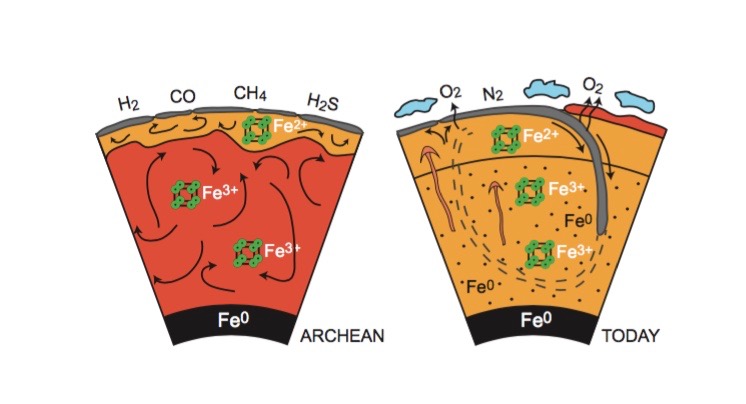- Home
- News
- General News
- Did Plate tectonics...
Did Plate tectonics aid the development of life on Earth?
24-01-2018
The appearance of plate tectonics 2.5 billion years ago, favouring the internal dynamics of the Earth, would have allowed a significant release of oxygen in the atmosphere inducing the development of life on our planet, according to a study published by the journal Geochemical Perspectives
The Earth’s atmosphere remained anoxic for two billion years after the formation of our planet. Then, its oxygen content increased drastically during a well-identified Great Oxygenation Event. It is generally believed that the release of free oxygen was due to the biosphere itself, in relation with the evolution of life on Earth. An international team of researchers from Laboratoire Magmas et Volcans (Université Clermont-Ferrand, CNRS-IRD-OPGC), Géosciences Montpellier (Université de Montpellier, CNRS), the laboratory Conditions Extrêmes et Matériaux: Haute Température et Irradiation (CNRS), and involving five scientists from the ESRF propose a completely different scenario. Based on the experimental observation of a significant amount of ferric iron in the deep Earth’s mantle, they suggest an ascent toward the Earth’s surface of a primordial oxidised-mantle material, inducing the arrival of oxygen into the atmosphere. The upwelling movements would have been hampered during the Archean eon, which was dominated by floating micro-plates at the Earth’s surface. Then, major mantle mixing started when modern plate tectonics and deep slab subduction were established about 2.5 billion years ago, enabling the release of oxygen to the Earth’s surface.

During the Archean, the oxidised deep mantle remained isolated from the Earth’s surface because of a tectonic regime characterised by almost no subduction. At that time, the atmosphere was anoxic. The transition to modern plate tectonics that occurred 2.5 billion years ago greatly enhanced mantle mixing. Subduction of slabs associated to global mantle convection induced ascent of deep oxidised mantle material and fresh lavas reached the Earth’s surface. Large amounts of oxygen were potentially degassed, due to the increase in volcanic fluxes and other sub-surface exchange processes.
This thermochemical evolution could have been fairly chaotic as it resulted in major ultramafic volcanic events greatly increasing the amount of fresh lava rising to the Earth’s surface. Interestingly, it is around the same period that the Earth’s atmosphere experienced the Great Oxygenation Event, which is a major step on the course of life evolution on Earth.
As explained by Denis Andrault “This type of time-coincidence is rarely fortuitous in Nature. That’s why we thought that we could make a link between the thermochemical evolution of the interior of the Earth and the oxygen content of the atmosphere ".
For the first time, the authors of this study suggest a global scenario that correlates the timing and the amplitude of the Great Oxygenation Event with the dynamical evolution of the interior of our planet along the geological ages. The scenario first describes a primordial deep mantle relatively rich in oxygen due to the removal of metallic iron at the earliest period of the core formation. It is the most abundant mantle phase, the Al-bearing (Mg,Fe)SiO3 bridgmanite, that can incorporate significant amounts of ferric iron (Fe3+) and thus a relative excess in oxygen.
For this study, the team use both X-ray absorption spectroscopy and Mossbauer spectroscopy and carried out experiments at two ESRF beamlines (ID24 and ID18). “From the experimental point of view, the challenge here was to determine a quantitative estimate of the proportion of Fe3+ in the deep mantle, where Fe is found in different minerals. The ESRF presently operates the only instruments worldwide, i.e., a double-sided laser heating facility coupled to an energy dispersive XAS beamline (ID24), and to a nuclear resonance beamline (ID18) capable of probing the local and electronic structure of matter at conditions relevant to the Earth’s mantle,” explained Sakura Pascarelli, Aleksandr Chumakov and Valerio Cerantola from ESRF.
As underlined by Denis Andrault, “The fate of such primordial oxygen-excess is key for our understanding of the redox state of our planet. For the 2 - 2.5 billion years after the formation of our planet, the oxidised material remained hidden in the deep Earth’s interior. When plate tectonics and deep slab subduction started to mix the entire mantle from very deep to the Earth’s surface, the excess of oxygen was released into the atmosphere. It induced a major thermochemical evolution of the atmosphere, to which terrestrial life has adapted with major biological developments”
Publication:
Large oxygen excess in the primitive mantle could be the source of the Great Oxygenation Event. D. Andrault, M. Muñoz, G. Pesce, V. Cerantola, A. Chumakov, I. Kantor, S. Pascarelli, R. Rüffer, L. Hennet. Geochemical Perspective letters. January 17th, 2018. DOI: 10.7185/geochemlet.1801



